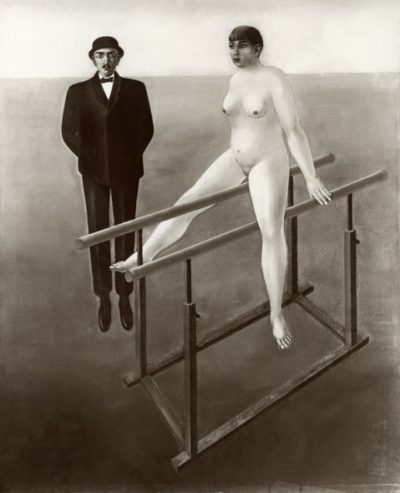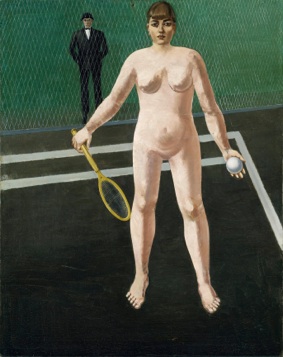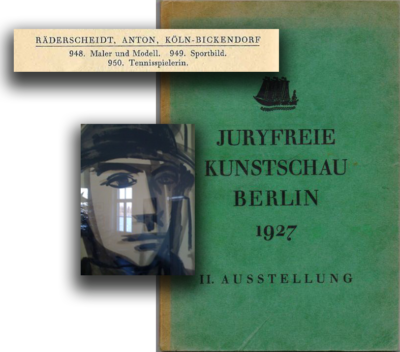Anton Räderscheidt
Painter of the New Objectivity
1942-1947

Nude on parallel bars, 1925
Oil on Canvas
Whereabouts unknown


Franz Roh 1926 Lucia Moholy
In 1930, Roh discusses the “Act On Bars” in his contribution “Two People”, with which he partook in a competition for best art criticism advertised by the art magazine “Kunstblatt”. He emphasizes the contrasts in composition and content and provided a description of the painting using powerful language which analyzes the alienation and isolation of the sexes and congenially puts it into words:
Franz Roh 1930, p. 103 “The petrified nature of the process, the eerily mute and disguised aspect of the yet so drastic gesture of opening oneself. Strange contrasts: the impenetrable encapsulation of the man, who stands walled in as if in armor in his dark suit, in contrast to the relentless nakedness of the woman. One also senses how the pitch-black of the man steps behind the moonlight of the woman, how his closed form (everything with him in projecting parallelisms) increases the openness and angulation of the woman’s body. How the dark-edged modeling contrasts with the white smoldering form, how the device finally places diagonal pull and spatial tension in the middle of the spatially uncertain ground-level, which wanted to suck in both bodies regionwide. […] Metallic solidification of every impulse of life. Last people on a star that has long since cooled, in absolute loneliness against themselves and against ‘that’ ground that never becomes a surface to stand on. Therefore, instead of heavyweight or ponderation, being clamped between heaven and earth like marionettes. The horizon cutting through their necks. The visual tensions of the heads riveted in infinity. It’s a miracle that such naturalistic types as this gentleman with a bowler hat and patent-leather shoes and this mere nude model of the studio never fall out. It’s done by the most secretive means: very quiet cylinderization of the man let him [them] loom like a dark machine piston. And imperceptible stylization of the feet and hands, for example, makes the woman almost seem like an alienated body.”
… By describing the position of the nude figure on the parallel bars, but not naming it specifically, Roh blends out the aspect of gymnastics and abstracts what is bizarre in the sports context: the “relentless nudity” from the situation. Instead, Roh compares the “openness” of the female body, which is described as a “white swollen form”, with the “machine piston” of the male body, which in turn is in a suit of armour. The contrast resonating in the subtext is an old paradigm: the woman belongs to the sphere of nature, the man to the sphere of culture, here explicitly to technology. IV Roh thus emphasizes the quality of the magic realism in Räderscheidt, which is detached from any temporality. The image’s unbridgeable alienation of the sexes is heightened to universal validity: “Human beings are used as the silent bridge between birth and death, between the two forms of great nothingness. How these bodies are clamped between the borders of the picture panel itself is something Roh had written years earlier about the composition of the pictures. Despite its surreal timelessness, the provocative potential of the “Act On Bars” lies precisely in the time-specific combination of act and sport, the opposing entanglement of sexuality and derotization, which has already been established in the example of the “The Tennis Player”, new women and emancipation. In this case, the act straddles the legs on the piece of sports equipment, which Beate Reese interprets as a substitute for prevented sexuality, whereas Hans Jürgen Maes interprets it as an aggressive display of just the same. In the Tac, contemporaries connect erotic associations with parallel bar gymnastics, to which Joachim Ringelnatz also alludes in his poem “On the bars (Alla Donna tedesca). In the first edition of the volume “Turngedichte”, published in 1920, he ironically ironizes both the connection between sport and emancipation as well as the nationalistic direction of gymnastics.
1 Walter, Maria: Anton Räderscheidts Paarbilder in den 20er Jahren. In: Anzeiger des Germanischen Nationalmuseums und Berichte au.s dem Forschungsinstitut für Realienkunde [o. Jg.) 1991. S. 275-302. hier S. 285 und 292.
II Heusinger von Waldegg spricht vom „Zwang zu chaplinesker Maskerade des Mannes”.
(Heusinger von Walde,gg. Joachim: Zur Ikonographie der „ einsamen Paare” bei Anton Räderscheidt. In: Pantheon )◄ ( 1979, H. 1). S. S9-68. hier S. 67.)
III Roh, Franz: Zwei Menschen. In: Das Kunstblatt 14 (1930). S. 100-103. hi er S. 103
.i v Vd, hierzu u.a. Pointon, Marcia: Naked Authority: The Body in Western Painting
18)0-1908. Cambridge. New York, Metbourne 1990. S. 17-3◄
v Roh. Franz: Zur jüngsten niederrheinischen Malerei. In: Das Kunstblatt 10 (1926). S. 363-368. hier S. 366. vi Vgl. Reese. Beate: Melancholie in der Malerei der Neuen Sachlichkeit. Frankfurt a.M. u.a. 1998 (= Europäische Hochschulschriften. Reihe XXVIII: Bd. 321) (zugl: Bochum. Univ .. Oiss„ 1996). s. 126. vii Vgl. Maes. Hans-Jürgen: ldentitatsbeschaffung in der einer totalitaren Gegenwart. Perspektive, Horizont und Balance in den Sportbildern Anton Räderscheidts. In: Anton Räderscheidt. Hg. von Werner Schafke und Michael Euler-Schmidt (Au sst. Kat. Köln, Josef H aubr ich-Kunsthalle). Köln 199). S. 9-18. S. 1◄.